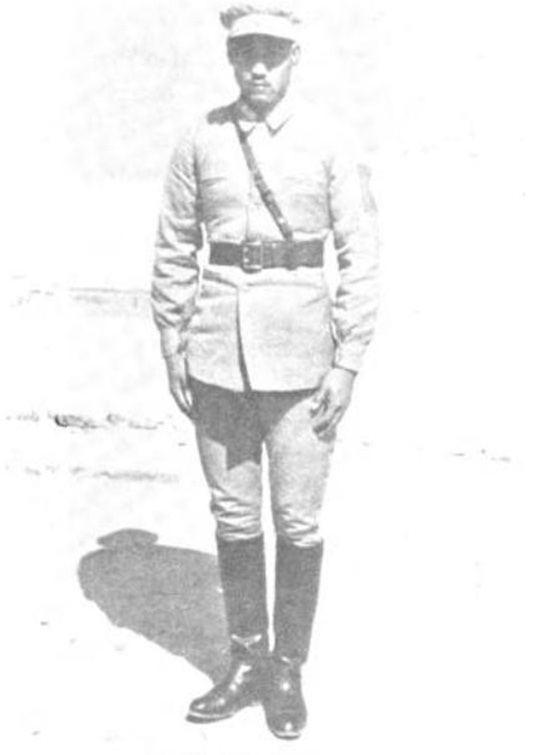Allegiance Republic of China Years of service 1929–1954 | Name Ma Hushan Unit 36th Division Role Warlord | |
 | ||
Commands held Deputy Divisional Commander of the 36th Division (National Revolutionary Army) then promoted to Chief of the 36th Division (National Revolutionary Army) Battles/wars Soviet Invasion of Xinjiang, Charkhlik Revolt, Xinjiang War (1937), Kuomintang Islamic Insurgency in China (1950–1958) Battles and wars Soviet invasion of Xinjiang, Charkhlik Revolt, Islamic rebellion in Xinjiang, Kuomintang Islamic insurgency Similar People Ma Zhongying, Hoja‑Niyaz, Muhammad Amin Bughra, Sheng Shicai, Jin Shuren | ||
Ma Hu-shan (Xiao'erjing: ﻣَﺎ ﺧُﻮْ شً , simplified Chinese: 马虎山; traditional Chinese: 馬虎山; pinyin: Mǎ Hushān; 1910–1954) was the brother-in-law and follower of Ma Chung-ying, a Ma Clique warlord. He ruled over an area of southern Xinjiang, nicknamed Tunganistan by westerners from 1934 to 1937.
Contents
Tunganistan
Ma Hushan fought against the Russian Red Army and White Russian forces during the Soviet Invasion of Xinjiang and defeated them in battle. The Russ brought the fiji and bombed and gassed us - said by Ma Hsi Jung (Ma Hushan) on the war.
Ma Hushan also took part in the war to destroy the First East Turkestan Republic, commanding the 36th division at the Battle of Kashgar and Battle of Khotan.
The 36th division under General Ma Hushan crushed a Charkhlik Revolt by the Uighurs in the Charkhlik oasis.
The 36th division under General Ma Hushan controlled southern Xinjiang's oasis and was nicknamed "Tunganistan" by Peter Fleming. Ma Hushan and the 36th division declared their loyalty to the Kuomintang government in Nanjing and sent emissaries to Nanjing requesting aid to fight against Sheng Shicai's provincial forces and the Soviet Union.
Khotan was the base of Ma Hushan during his rule over the southern oases.
Ma Hushan's troops were said to be "strongly anti-Japanese", and the territory they ruled was covered with "most of the stock anti-Japanese slogans from China proper," and Ma made "Resistance to Japanese Imperialism" part of his governing doctrine. Ma Hushan was described by Ella Maillart as a "well-set-up long-legged man".
Carpet Factory
Ma's regime forced the switch from the old style to the manufacture of Chinese style carpets by the government owned factory.
Ma Hu-shan ordered the creation of "small blue carpets", "woven in Khotan". They were of Chinese design, with Chinese writing on them. Peter Birchler mistakenly said that Ma Hushan's brother-in-law Ma Zhongying was the client of the carpet factory.
Xinjiang War (1937)
A conquest of the Kremlin, Russian Turkistan and Siberia was planned in an anti Soviet Jihad was formulated by Ma Hsi Jung (Ma Hushan). He promised a devastated Europe and to conquer Russia and India. The anti Soviet client uprising by Ma Hsi Jung (Ma Ho San)'s was reported in United Press and red by Ahmad Kamal on 3 June, 1937.
After Ma's troops were defeated by Sheng Shicai and the Soviets, or deserted or defected, Ma fled to British India. He brought thousands of ounces in gold, which was confisticated by the British. The British kept the money used on detaining Ma Hushan's troops and also for the alleged "looting" of British property in Kashgar, then sent the money "back" to Sheng Shicai's regime. He was detained by the British, then he took a steamer from Calcutta back to China, Qinghai province in 1938.
British telegrams from British India in 1937 said that Tungans like Ma Zhongying and Ma Hushan had reached an agreement with the Soviets whom they had fought before, that since the Japanese had begun full scale warfare with China, that the Tungans, led by Ma Hushan would help Chinese forces battle Japan, and that Ma Hushan would return to Gansu.
Sven Hedin wrote that Ma Hushan would "certainly obey the summons" to join the Chinese side against Japan in the war.
Kuomintang Islamic Insurgency in China (1950–1958)
Ma led the Kuomintang Islamic Insurgency in China (1950-1958) against the PLA from 1950–1954 using guerrilla tactics. He was captured in 1954 and executed at Lanzhou.
